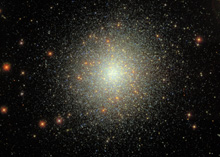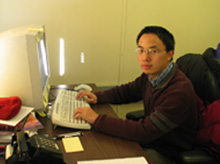 | Wednesday, January 26, 2005 |
|
Wednesday, January 26 11:00 a.m. Fermilab ILC R&D Meeting - 1 West Speaker: V. Kuchler, Fermilab Title: ILC Conventional Facilities Update Speaker: J. Jackson, Fermilab Title: Recent Development in ILC Communications 3:00 p.m. Proton Driver General Meeting - 1 West Speaker: D. Bogert, Fermilab Title: Civil Construction for Proton Driver Linac 3:30 p.m. DIRECTOR'S COFFEE BREAK - 2nd Flr X-Over 4:00 p.m. Fermilab Colloquium - 1 West Speaker: S. Geer, Fermilab Title: Physics at a New Fermilab Proton Driver
Thursday, January 27 |
|
Extended Forecast |
Secon Level 3 |
|
Wednesday, January 26 Portabello Harvest Grain Soup Santa Fe Chicken Quesadilla $4.75 Garlic Herb Roasted Pork $3.75 Jambalaya $3.75 Roast Beef on Ciabatta w/ Red Pepper Mayo $4.75 Meatlover's Pizza $2.75 Pesto Shrimp Linguini with Leeks & Tomatoes $4.75
Wilson Hall Cafe Menu |
| Fermilab Today is online at: http://www.fnal.gov/today/ Send comments and suggestions to today@fnal.gov Fermilab Today archive Fermilab Today PDF Version Fermilab Result of the Week archive Fermilab Safety Tip of the Week archive Linear Collider News archive Fermilab Today classifieds Subscribe/Unsubscribe to |
|
From The New York Times, January 25, 2005 Brace Yourself! Here Comes Einstein's Year By Dennis Overbye "What are you up to, you frozen whale, you smoked, dried, canned piece of soul?" So did Albert Einstein, then a 26-year-old patent clerk in Bern, Switzerland, begin a letter to his pal Conrad Habicht in the spring of 1905.
Whatever Habicht, a math teacher in Schaffhausen, had been up to was not much compared to his irreverent friend, who had been altering the foundations of physics during the few free hours left to a young father, husband and government worker. As he related to Habicht, Einstein had just finished writing three major physics papers.
|
|
From the Chicago Tribune, January 25, 2005 The competitive edge Argonne National Laboratory, near Lemont, is a leading contender for the $1 billion research facility called the Rare Isotope Accelerator. Its chief competitor for this U.S. Department of Energy project is Michigan State University in East Lansing. The DOE is expected to choose a site late this spring.
This is a critical project--the DOE ranks it third on a priority list of 28 research projects deemed critical to the nation's future over the next two decades. It is expected to be the world's leading facility for nuclear science research.
|
|
Universities Help on Booster Projects This article is the second in a series that will focus on the benefits of Fermilab/University collaboration on different accelerator projects. | ||
| ||
|
With many accelerator projects on the horizon, Fermilab is encouraging university groups to get involved in accelerator projects such as those with the Fermilab Booster, in order to create a better balance between detector physics and accelerator physics. Currently, for example, each large collider experiment at Fermilab has about 600 scientists, while the Accelerator Division has about 150 scientists.
In the past, particle physics detectors have typically been of equal or greater complexity than the accelerators at which they have operated, but that's changing. "It's very valuable for experimenters to understand accelerators and their potential problems," said Eric Prebys of Fermilab's Accelerator Division who works on the Booster. "Working on the accelerators is also a different environment than working on the detectors, and some people are attracted to that." Because Booster performance plays a critical role in the success of the MiniBooNE and NuMI/MINOS experiments, physicists and universities from these groups have offered a great deal of help to the Booster. "MiniBooNE collaborators contributed early on to the development of ramping corrector magnets in the Booster," Prebys said. "Both collaborations have also helped by contributing their machine shops to build components for copper RF cavities, which universities built at a fraction of the price Fermilab would have paid to build the cavities on its own." Other more speculative projects include Columbia University's assistance in developing a robot capable of going into high radiation areas. Graduate students have also contributed to the Booster through the Fermilab Accelerator PhD program. Xiaobiao Huang, from the University of Indiana, has been working on precision modeling of the Booster, and Bob Zwaska, from the University of Texas at Austin has been working on the synchronization of the Booster with the Main Injector.
Next: NuMI
|
|
February issue of symmetry Available Online The February issue of symmetry is now available online. Fermilab employees will receive a print copy of the latest issue in their mailboxes tomorrow.
Site Listserv Upgrade
URA Scholarship Applications Now Available
Unix Users Meeting
January PC Manager Meeting
The next PC Manager Meeting will be on
Wednesday, January 26, from 9 to10 a.m. in WH8X (Hornets Nest).
Recreation Office Offers Discount to Employee Printing Services
International Folk Dancing
|

